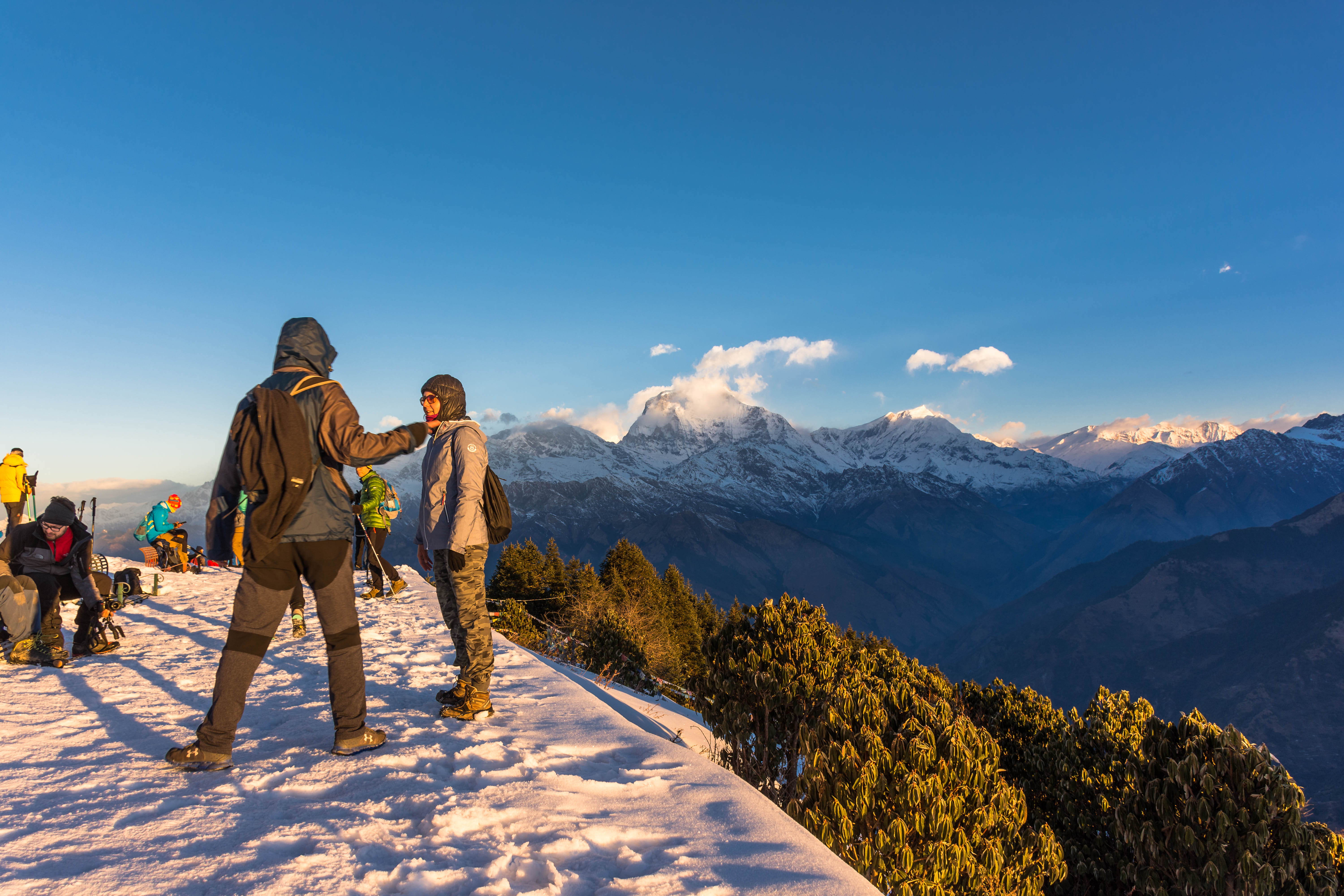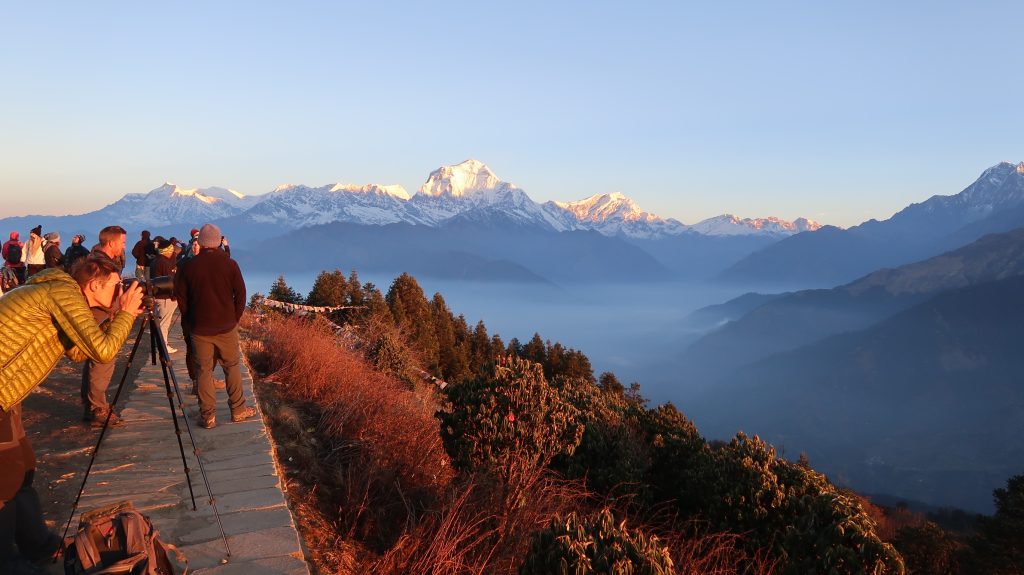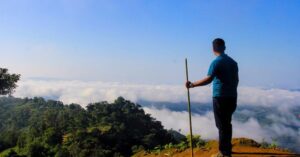Introduction
Welcome to the captivating world of Poon Hill, where adventure and natural beauty intertwine to create a mesmerizing experience. In this article, we will take you on a journey to explore the wonders of Poon Hill and provide you with all the essential information to plan an unforgettable trek. From the breathtaking views of the Annapurna and Dhaulagiri ranges to the cultural encounters along the trail, Poon Hill offers a delightful escape into the heart of the Nepalese Himalayas.
The Beauty of Poon Hill
Magnificent views of the Annapurna and Dhaulagiri ranges:
Poon Hill stands as a vantage point that offers panoramic views of the majestic Annapurna and Dhaulagiri ranges. As the sun rises and casts its golden hues on the snow-capped peaks, you will be left awe-struck by the sheer beauty that unfolds before your eyes. The towering mountains, including Annapurna I, Annapurna South, Machhapuchhre (Fishtail), and Dhaulagiri, create a stunning backdrop that leaves an indelible mark on your memory.

Breathtaking sunrise and sunset of Poon Hill:
one highlight of the Poon Hill trek is the opportunity to witness breathtaking sunrises and sunsets. The early morning hike to Poon Hill rewards you with a magical spectacle as the first rays of the sun paint the sky in hues of orange and pink. The tranquil beauty of the landscape bathed in the warm glow of sunlight is a sight to behold. Similarly, the sunset views from Poon Hill are equally enchanting, offering a serene ambiance as the sun bids farewell for the day.
Planning Your Poon Hill Trek
Choosing the right season:
The choice of the season influences your Poon Hill trek experience. The best time to visit is during the spring (March to May) and autumn (September to November) seasons when the weather is favorable, and the skies are clear. These seasons offer pleasant temperatures, are ideal for trekking, and provide excellent visibility for mountain views.
Duration and difficulty of the trek in Poon Hill:
The Poon Hill trek is a moderate-level trek that can be completed in about 5 to 8 days, depending on your pace and preferences. The trail encompasses both ascents and descents, providing a balanced challenge for trekkers of various fitness levels. It is important to acclimatize properly and listen to your body’s needs during the trek.
Required permits and fees for Poon Hill Trek:
To embark on the Poon Hill trek, you will need two permits: the Annapurna Conservation Area Permit (ACAP) and the Trekkers’ Information Management System (TIMS) card. These permits help support conservation efforts and maintain the trekking infrastructure. There may be entry fees for certain areas along the trail, so it is advisable to check the latest information and carry the documentation.
Poon Hill Trek Itinerary
Day 1: Arrival in Kathmandu:
Your Poon Hill adventure begins with your arrival in Kathmandu, the vibrant capital city of Nepal. Take some time to explore the city’s rich cultural heritage, visit ancient temples, and indulge in the local cuisine.
Day 2: Travel to Pokhara:
On the second day, embark on a scenic drive or a short flight to Pokhara, the gateway to the Annapurna region. Pokhara’s serene lakeside setting and breathtaking mountain views create a perfect atmosphere to relax and prepare for your trek.
Day 3: Drive to Nayapul and trek to Tikhedhunga:
Start your trek by driving to Nayapul and begin your hike towards Tikhedhunga. The trail takes you through picturesque landscapes, charming villages, and terraced fields, offering glimpses of the local way of life.
Day 4: Trek from Tikhedhunga to Ghorepani:
This day involves a challenging ascent towards the beautiful village of Ghorepani. As you make your way up, immerse yourself in the lush rhododendron forests, listening to the melodies of birds and relishing the natural beauty around you.
Day 5: Poon Hill sunrise hike and trek to Tadapani:
Rise early in the morning and embark on a memorable hike to Poon Hill to witness the awe-inspiring sunrise. The panoramic views of the Himalayan peaks bathed in the golden light of the rising sun are truly unforgettable. After soaking in the beauty, trek to Tadapani, passing through dense forests and enjoying the tranquility of nature.
Day 6: Trek to Ghandruk:
On this day, you will trek to the picturesque village of Ghandruk, known for its rich Gurung culture and traditional houses. Explore the village, interact with the friendly locals, and immerse yourself in their warm hospitality.

Day 7: Trek to Nayapul and drive to Pokhara:
Descend from Ghandruk to Nayapul, marking the end of your trekking journey. From Nayapul, take a scenic drive back to Pokhara, where you can relax and rejuvenate, reflecting on the incredible experiences of the past days.
Day 8: Return to Kathmandu:
Conclude your Poon Hill adventure by either taking a flight or a drive back to Kathmandu. Use this day to explore more of the city, shop for souvenirs, and savor the flavors of Nepalese cuisine.
Essential Packing List for Poon Hill Trek
1. Clothing and footwear:
- Comfortable trekking pants and shirts
- Warm layers (fleece jackets, down jackets)
- Waterproof and windproof outer shell
- Sturdy and comfortable hiking boots
- Woolen socks and thermal undergarments
- Sun hat and sunglasses
2. Trekking gear and equipment:
- Backpack with a rain cover
- Sleeping bag suitable for cold temperatures
- Trekking poles for stability and support
- Headlamp with extra batteries
- Water bottles and water purification tablets
- lightweight and quick-drying towel
3. Toiletries and medication:
- Basic toiletries (toothbrush, toothpaste, soap)
- Sunscreen with high SPF
- Lip balm with UV protection
- First aid kit including necessary medications (altitude sickness pills, pain relievers, anti-diarrheal tablets)
Training and Physical Preparation
Cardiovascular exercises:
Engage in activities like jogging, swimming, or cycling to improve your cardiovascular fitness. Aim for at least 30 minutes of moderate-intensity exercise on most days of the week to enhance your endurance.
Strength and endurance training:
Incorporate strength training exercises such as squats, lunges, and planks to strengthen your leg muscles and core. Practice hiking with a loaded backpack to simulate the conditions of the trek and improve your endurance.
Acclimatization tips:
Gradual acclimatization is crucial to avoid altitude sickness. During the trek, take regular breaks, maintain a steady pace, and stay hydrated. Listen to your body and be mindful of any symptoms of altitude sickness, such as headaches or shortness of breath.
Safety Tips for Poon Hill Trek
Hiring a professional guide or porter:
Consider hiring a knowledgeable guide or porter who can provide guidance, carry your belongings, and ensure your safety throughout the trek. Their experience and local expertise can enhance your trekking experience.

Staying hydrated and maintaining proper nutrition:
Drink plenty of water and stay hydrated to prevent altitude-related illnesses. Carry energy bars, nuts, and high-calorie snacks to maintain your energy levels during the trek.
Avoiding altitude sickness:
Ascend slowly, allowing your body to acclimatize effectively. Listen to your guide’s recommendations and be aware of symptoms of altitude sickness. Descend immediately if symptoms worsen or persist.
Accommodation and Dining Options
Tea houses and lodges along the trail:
The Poon Hill trek offers a range of accommodation options as tea houses and lodges. These establishments provide basic facilities such as clean rooms, cozy beds, and communal dining areas. Embrace the simplicity of mountain living and enjoy the warm hospitality of the locals.

Local food and beverage choices:
Along the trekking trail, you will savor traditional Nepalese dishes. Indulge in dal bhat (lentil soup with rice), Momo (steamed dumplings), and Sherpa stew, which are popular choices among trekkers. Do not forget to try the local herbal tea, a comforting and rejuvenating beverage.
Cultural Highlights of the Poon Hill Trek
Interactions with ethnic communities in Poon Hill:
The Poon Hill trek allows you to immerse yourself in the vibrant cultures of the ethnic communities living in the region. Interact with the Gurung and Magar communities, learn about their traditions, and gain insights into their way of life.
Traditional festivals and rituals in Poon Hill:
Depending on the time of your visit, you may can witness traditional festivals and rituals celebrated by the local communities. These festivities provide a glimpse into the rich cultural heritage of the region and offer a unique experience for trekkers.
Environmental Considerations
Responsible trekking practices:
Respect the natural environment by following responsible trekking practices. Stay on designated trails, dispose of waste properly, and minimize your ecological footprint. Leave the trails cleaner than you found them.
Waste management and conservation:
Carry a reusable water bottle to minimize plastic waste. Dispose of waste in designated bins or carry it back to the nearest village for proper disposal. Respect the fragile ecosystems and wildlife by avoiding any disturbance to their natural habitats.
The Best Time to Visit Poon Hill
Weather conditions and seasons:
The spring season (March to May) and autumn season (September to November) offer the best weather conditions for the Poon Hill trek. During these seasons, the skies are clear, and the temperatures are moderate, making for a comfortable and enjoyable trekking experience.
Peak tourist seasons and crowd considerations:
The peak tourist seasons of spring and autumn attract a larger number of trekkers to Poon Hill. If you prefer a quieter trek, consider visiting during the shoulder seasons of early spring or late autumn when the trails are less crowded.
Capturing Memories: Photography Tips
Equipment recommendations:
Carry a sturdy DSLR camera or a high-quality smartphone with a good camera. A wide-angle lens is ideal for capturing the expansive mountain vistas, while a telephoto lens can help you capture details of the landscapes and wildlife.
Composition and lighting techniques:
Experiment with different angles and perspectives to capture unique shots. During sunrise and sunset, utilize the soft, warm light to create stunning photographs. Incorporate elements like prayer flags, traditional houses, and colorful landscapes to add depth and interest to your images.
Benefits of the Poon Hill Trek
Physical and mental well-being:
The Poon Hill trek offers an excellent opportunity to improve your physical fitness and stamina. The serene environment, fresh mountain air, and physical exertion contribute to a sense of well-being and rejuvenation. The trek also provides a break from the hustle and bustle of daily life, allowing for mental relaxation and reflection.
Immersion in nature and culture:
Immerse yourself in the pristine beauty of the Himalayan landscapes and experience the rich cultural heritage of the local communities. The trek offers a unique blend of natural wonders and cultural encounters that leave a lasting impact on trekkers.
Conclusion
Embarking on the Poon Hill trek is an adventure that combines breathtaking mountain vistas, cultural immersion, and a sense of accomplishment. The trek offers a balance of moderate-level challenge and rewarding experiences, making it an ideal choice for trekkers of various skill levels. From the enchanting sunrise views at Poon Hill to the warm hospitality of the local communities, every moment of the trek is filled with wonder and awe. So, lace up your hiking boots, prepare your backpack, and get ready to create memories that will last a lifetime on the mesmerizing Poon Hill trek.
FAQs (Frequently Asked Questions)
Is prior trekking experience necessary for the Poon Hill trek?
Prior trekking experience is not necessary for the Poon Hill trek. However, it is recommended to have a basic level of fitness and stamina to enjoy the trek comfortably.
Are there any age restrictions for the Poon Hill trek?
There are no specific age restrictions for the Poon Hill trek. However, it is important to consider the physical fitness and endurance level of everyone, especially for elderly or young trekkers.
What is the average daily trekking duration on the Poon Hill trek?
The average daily trekking duration on the Poon Hill trek is around 5 to 6 hours, covering approximately ten kilometers. However, the actual duration may vary depending on the pace of the group and individual fitness levels.
Are there any altitude-related risks on the Poon Hill trek?
While the Poon Hill trek does not reach extremely high altitudes, there is still a possibility of experiencing altitude sickness. It is essential to acclimatize properly, stay hydrated, and listen to your body’s signals to avoid any altitude-related risks.
Can the Poon Hill trek be customized to include other destinations or activities?
Yes, the Poon Hill trek can be customized to include additional destinations or activities. Many trekkers combine the trek with visits to other popular destinations in Nepal, such as Chitwan National Park or the Kathmandu Valley, to create a comprehensive travel experience.







